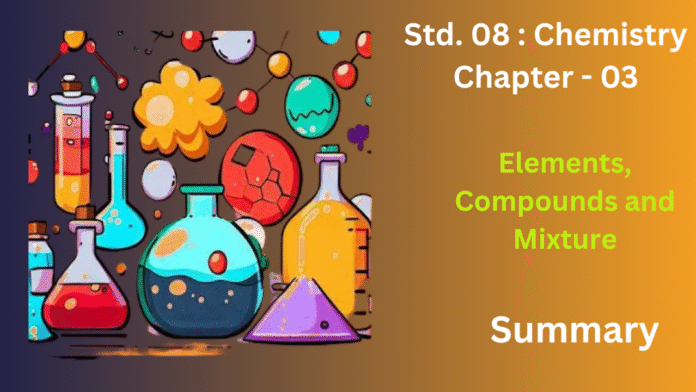Understanding the fundamental building blocks of matter is key to comprehending the world around us. At the simplest level, we have elements. Think of them as the basic ingredients – each made up of just one type of atom. You can’t break down oxygen, iron, or carbon into anything simpler using chemical methods; they are as fundamental as it gets.
When these elements decide to get together in a very specific way, they form compounds.The fascinating thing about compounds is that their properties are completely different from the elements that make them up. Take water, for instance (H2O): it’s made of hydrogen and oxygen, but its characteristics are unique to itself.
Finally, we have mixtures, which are a bit more relaxed. Here, substances (which can be elements or compounds) simply get together physically, without forming any new chemical bonds. Because there’s no chemical reaction, each component in a mixture keeps its original properties. This also means you can often separate them using physical methods – think of sifting sand from sugar. Mixtures can be quite uniform, like salt dissolved in water (a homogeneous mixture), or visibly uneven, like sand and water (a heterogeneous mixture).
Exercise 3(A)
Question 1.
Define: (a) Elements (b) Compounds
Answer:
(a) Elements: Consider elements to be the irreducible, most basic forms of chemical substances. For instance, every atom of oxygen is identical to every other atom of oxygen, and it cannot be chemically transformed into a simpler substance. Elements possess distinctive physical and chemical properties that set them apart from one another, and they are the foundational components from which all other substances are formed.
(b) Compounds: When two or more distinct elements come together and chemically bond in fixed, precise proportions, they form a compound. This chemical union results in a new substance with properties that are often dramatically different from those of the constituent elements. A familiar example is water, a compound formed from the chemical combination of hydrogen and oxygen. While hydrogen is a flammable gas and oxygen supports combustion, their chemical union yields water, a liquid that extinguishes fires. This transformation of properties is a hallmark of compound formation, demonstrating that the whole is often far more than the sum of its individual elemental parts.
Question 2
Give two examples for each of the following:
(a) Metals (b) Non-metals
(c) Metalloids (d) Inert gases
Answer:
Metals
Iron (Fe) is a ubiquitous and indispensable metal, forming the backbone of modern infrastructure. Its remarkable strength and widespread availability make it a primary material in construction (especially as steel), manufacturing, and countless other industrial and everyday applications.
Copper (Cu) stands out for its exceptional electrical conductivity and malleability. These properties make it invaluable for electrical wiring, plumbing systems, and even coinage.
Non-metals
Oxygen (O) is a fundamental element, crucial for both respiration in living organisms and the process of combustion. It’s an abundant component of Earth’s atmosphere and an essential part of water molecules.
Carbon (C) is truly the foundation of all organic life.
Metalloids
Silicon (Si) Its unique property of conducting electricity under specific conditions makes it indispensable for semiconductors, microchips, and solar cells.
Germanium (Ge) is another significant semiconductor material. It plays a vital role in transistors, diodes, and advanced technologies like fiber optic systems.
Inert Gases
Neon (Ne) is widely recognized for its vibrant application in “neon” signs, where it emits a distinct bright orange-red glow when an electric current passes through it.
Argon (Ar) is commonly employed as an inert shielding gas in welding to prevent unwanted oxidation of materials. It’s also used in incandescent light bulbs to extend the lifespan of the filament
Question 3.
Differentiate between:
(a) Pure and impure substances
(b) Homogenous and heterogenous substances
Answer:
(a) Pure vs. Impure Substances:
Pure stuff is just one type of tiny particle, always the same, with set characteristics like when it melts or boils. Think of pure water or gold. Impure stuff, or mixtures, is a blend of different particles that aren’t bonded together. They don’t have a fixed recipe or exact properties, like the air we breathe or the soil.
(b) Homogenous vs. Heterogenous Substances:
Homogenous mixtures look the same all the way through; you can’t spot the different ingredients. Saltwater is a good example. Heterogenous mixtures are chunky; you can clearly see the different parts mixed in, like sand in water or the toppings on a pizza
Question 4.
Write the chemical name of the following and also give their molecular formulae:
(a) Baking soda (b) Vinegar
(c) Marble (d) Sand
Answer:
Here are the chemical names and molecular formulae for the substances you listed:
(a) Baking soda:
- Chemical name: Sodium bicarbonate (or Sodium hydrogen carbonate)
- Molecular formula: NaHCO3
(b) Vinegar:
- Chemical name: Acetic acid (it’s a dilute solution of acetic acid in water)
- Molecular formula: CH3COOH (or C2H4O2)
(c) Marble:
- Chemical name: Calcium carbonate
- Molecular formula: CaCO3
(d) Sand:
- Chemical name: Silicon dioxide (though sand can have various compositions, silicon dioxide, often in the form of quartz, is the most common component)
- Molecular formula: SiO2
Question 5.
Name:
(a) a soft metal
(b) a metal which is brittle
(c) a non-metal which is lustrous
(d) a liquid metal
(e) a metal which is a poor conductor of electricity.
(f) a non-metal which is a good conductor of electricity.
(g) a liquid non-metal
(h) the hardest naturally occurring substance
(i) an inert gas
Answer:
(a) A soft metal: Sodium. This fascinating alkali metal is so incredibly soft that you can easily slice through it with a simple knife.
(b) A metal which is brittle: Bismuth. While we typically think of metals as being malleable or ductile, bismuth stands out as an exception. Instead of bending or deforming under pressure, it tends to shatter, much like a ceramic or glass.
(c) A non-metal which is lustrous: Iodine. This element breaks the mold for non-metals.
(d) A liquid metal: Mercury. Perhaps the most famous example of an unusual metal, mercury is unique because it remains in a liquid state at typical room temperatures. You’d recognize it from old thermometers or barometers.
(e) A metal which is a poor conductor of electricity: Lead. Though it’s definitely a metal, lead isn’t exactly an electrical superstar. Compared to metals like copper or silver, lead offers significantly more resistance to the flow of electricity, making it a relatively poor conductor.
(f) (f) A non-metal which is a good conductor of electricity: Carbon in the form of amorphous carbon (like charcoal or coke). While graphite is well-known, other forms of carbon, especially those with a somewhat disordered structure, can also conduct electricity quite well due to the presence of delocalized electrons. This property makes them useful in various applications where electrical conductivity is required from a non-metal.
(g) A liquid non-metal: Bromine. Unlike the solid or gaseous states we often associate with non-metals, bromine exists as a reddish-brown liquid at room temperature. It’s quite volatile, meaning it readily vaporizes into a gas.
(h) The hardest naturally occurring substance: Diamond. This magnificent gemstone, another allotrope of carbon, holds the title for the hardest naturally occurring substance on Earth. Its incredible hardness is why it’s used in industrial cutting tools and, of course, admired as a precious gem.
(i) An inert gas: Argon. It doesn’t readily form chemical bonds with other elements, earning it the “inert” label. You’ll find it used in light bulbs and as a protective atmosphere for welding.
Question 6.
How is sodium chloride different from its constituent elements ?
Answer:
Think about common table salt, sodium chloride. On its own, sodium is this soft, shiny metal that goes wild when it touches water or air – definitely not something you’d sprinkle on your fries! Then there’s chlorine, a nasty greenish gas that smells awful and is actually poisonous.
But when these two very different elements chemically join forces, they create something entirely new: sodium chloride. This stuff is the white crystals we know as table salt, which is stable, perfectly safe to eat, and even crucial for our bodies to function.
It’s a really clear illustration of how a chemical reaction can lead to a brand-new substance with properties that are nothing like the original elements. The way the atoms link up completely changes what they can do!
Question 7.
Why is iron sulphide a compound ?
Answer:
Iron sulfide is definitely a compound because it’s not just a blend of iron and sulfur; they’ve actually joined together chemically in a specific, unvarying recipe (that’s the fixed ratio by mass). This chemical bonding creates an entirely new substance, iron sulfide, which acts completely differently from the original iron (a magnetic, grey-black metal) and sulfur (a yellow non-metal).
Exercise 3(B)
Question 1.
Classify the following substances into compounds and mixtures:
Answer:
Carbon dioxide, air, water, milk, common, salt, blood, fruit juice, iron sulphide.
Carbon dioxide — (Compound)
air — (Mixture)
water — (Compound)
milk — (Mixture)
common salt — (Compound)
blood — (Mixture)
fruit juice — (Mixture)
iron sulphide — (Compound)
Question 2.
Give one example for each of the following types of mixtures
(a) solid-solid homogenous mixture
(b) solid-liquid heterogenous mixture
(c) miscible liquids
(d) liquid-gas homogenous mixture
Answer:
(a) Brass is an excellent example of a solid-solid homogeneous mixture. When copper and zinc are melted and then allowed to solidify, they combine to form a single, uniform solid material, where you can’t distinguish the individual metals.
(b) For a clear illustration of a solid-liquid heterogeneous mixture, look no further than sand and water. Even if you stir them vigorously, the sand particles will always settle at the bottom, remaining distinct from the water.
(c) When alcohol and water are mixed, they blend perfectly into one uniform liquid, making them a prime example of miscible liquids forming a homogeneous mixture. You can’t see separate layers or particles once they’ve combined.
(d) You’re spot on about air in aquarium water and carbonated drinks demonstrating a liquid-gas homogeneous mixture. In both cases, the gas (whether it’s air or carbon dioxide) dissolves evenly throughout the liquid, creating a consistent solution rather than bubbles floating on top (unless it’s oversaturated or agitated).
Question 3.
Suggest a suitable technique to separate the constituents of the following mixtures. Also give the reason for selecting the particular method.
(a) Salt from sea water
(b) Ammonium chloride from sand
(c) Chalk powder from water
(d) Iron from sulphur
(e) Water and alcohol
(f) Sodium chloride and potassium nitrate
(g) Calcium carbonate and sodium chloride
Answer:(a) Salt from sea water: Evaporation. Water leaves as vapor, salt remains.
(b) Ammonium chloride from sand: Sublimation. Ammonium chloride turns directly to gas, separating from sand.
(c) Chalk powder from water: Filtration. Chalk, being insoluble, is trapped by a filter.
(d) Iron from sulphur: Magnetic Separation. A magnet pulls away the iron, leaving sulphur.
(e) Water and alcohol: Fractional Distillation. Separates liquids based on their differing boiling points.
(f) Sodium chloride and potassium nitrate: Fractional Crystallization. Exploits solubility differences to selectively crystallize one from the other.
(g) Calcium carbonate and sodium chloride: Dissolve, Filter, Evaporate. Dissolve the salt, filter the insoluble chalk, then dry the salt solution.
Question 4.
(a) Define mixture.
(b) Why is it necessary to separate the constituents of a mixture.
(c) State four differences between compounds and mixtures.
Answer:
a) What Mixtures Are: Imagine a vibrant mosaic – each tiny tile, whether glass, ceramic, or stone, keeps its own distinct color and shape, even when arranged together to form a larger picture. This is much like a mixture. A mixture is simply a physical combination of two or more substances where each original substance maintains its individual chemical identity and properties. There’s no chemical reaction taking place between the components; they are just intermingled. If you look closely at a bowl of mixed nuts, you can easily spot the almonds, cashews, and peanuts, recognizing each for what it is.
(b) Why We Separate Mixtures: The ability to separate mixtures is incredibly valuable, both in our daily lives and in scientific and industrial settings. One primary reason is to extract a specific component that we want to use or study. Think about brewing coffee – you separate the flavorful liquid from the solid coffee grounds to enjoy your drink. Another common purpose is to remove undesirable elements, like filtering impurities from water to make it safe to drink. Beyond practical applications, separating mixtures allows us to delve deeper into the nature of each constituent part, understanding their unique characteristics and how they behave in isolation, which is fundamental to chemical analysis and various manufacturing processes.
(c) Compounds Versus Mixtures: Fundamental Distinctions:
Formation: The creation of a mixture is a straightforward physical act – you simply combine things, like stirring sugar into water. No new chemical bonds are formed. In stark contrast, a compound is born from a chemical reaction where different elements chemically link together, forming a completely new substance with its own unique molecular structure.
Composition: With a mixture, you have considerable freedom in how you combine the ingredients. You can make sweet tea by adding a little sugar or a lot, and it’s still sweet tea. However, the elements within a compound always combine in exact and unchanging proportions by weight. For instance, water (H2O) will always consist of two hydrogen atoms for every one oxygen atom – this ratio is fixed and inviolable.
Properties: The characteristics of a mixture are essentially a reflection of the properties of its individual components. Consider sodium (a highly reactive metal that explodes in water) and chlorine (a poisonous gas) combining to produce table salt (a stable, edible crystalline solid).
Separation: Disassembling a mixture into its original parts typically only requires physical methods.To break down a compound into its constituent elements, however, you must employ chemical reactions, which demand significant energy input to disrupt the powerful chemical bonds holding them together.
Question 5.
(a) What is chromatography ? For which type of mixture is it used ?
(b) What are the advantages of chromatography?
Answer:
Chromatography is a smart separation method scientists employ to isolate various substances within a mixture. Imagine it as a race track where the different ingredients of the mixture move at varying speeds through a special medium. This difference in speed leads to the components spreading out and becoming visible as separate entities. This technique shines when separating mixtures where everything is dissolved in the same liquid or gas.
Chromatography has some neat benefits. It can pull apart even really complicated mixtures into their individual parts. Plus, it only needs a tiny bit of the original mixture to do its job. It’s also a flexible method that can be tweaked to separate lots of different kinds of substances. Scientists can use it to figure out what’s in a mixture and also how much of each substance is present.
6. Choose the most appropriate answer from the options given below:
(a) a mixture of sand and ammonium chloride can be separated by
- filtration
- distillation
- sublimation
- crystallisation
Ans : sublimation
(b) A pair of metalloids are
- Na and Mg
- B and Si
- C and P
- HeandAr
Ans : B and Si
(c) Which of the following property is not shown by compounds?
- They are heterogeneous.
- They are homogeneous.
- They have definite molecular formulae.
- They have fixed melting and boiling points.
Ans : They are heterogeneous.
(d) A solvent of Iodine is
- Water
- Kerosene oil
- Alcohol
- Petrol
Ans : Alcohol
(e) Which of the gas is highly soluble in water ?
- Ammonia
- Nitrogen
- Carbon monoxide
- Oxygen
Ans : Ammonia


